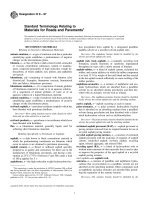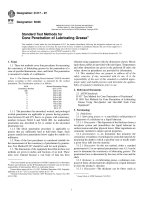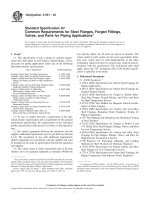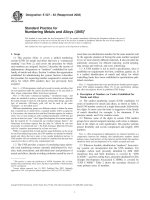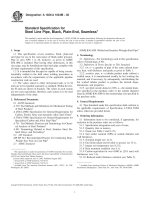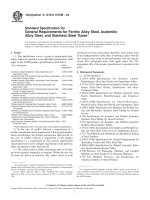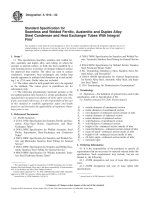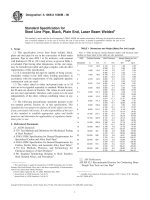Tiêu chuẩn ASTM D217
Bạn đang xem bản rút gọn của tài liệu. Xem và tải ngay bản đầy đủ của tài liệu tại đây (199.94 KB, 13 trang )
Designation: D 217 – 97
Designation: 50/88
AMERICAN SOCIETY FOR TESTING AND MATERIALS
100 Barr Harbor Dr., West Conshohocken, PA 19428
Reprinted from the Annual Book of ASTM Standards. Copyright ASTM
Standard Test Methods for
Cone Penetration of Lubricating Grease1
This standard is issued under the fixed designation D 217; the number immediately following the designation indicates the year of
original adoption or, in the case of revision, the year of last revision. A number in parentheses indicates the year of last reapproval. A
superscript epsilon (e) indicates an editorial change since the last revision or reapproval.
These test methods were adopted as a joint ASTM-IP standard in 1969.
These test methods have been adopted for use by government agencies to replace Method 311 of Federal Test Method Standard No. 791
b.
obtained using equipment with the dimensions shown. Metric
equivalency tables are provided with each figure. Temperatures
and other dimensions are given in the preferred SI units; the
values shown in parentheses are provided for information.
1.4 This standard does not purport to address all of the
safety concerns, if any, associated with its use. It is the
responsibility of the user of this standard to establish appropriate safety and health practices and determine the applicability of regulatory limitations prior to use.
1. Scope
1.1 These test methods cover four procedures for measuring
the consistency of lubricating greases by the penetration of a
cone of specified dimensions, mass, and finish. The penetration
is measured in tenths of a millimetre.
NOTE 1—The National Lubricating Grease Institute2 (NLGI) classified
greases according to their consistency as measured by the worked
penetration. The classification system is as follows:
NLGI
Consistency Number
000
00
0
1
2
3
4
5
6
Worked Penetration Range,
25°C (77°F)
445 to 475
400 to 430
355 to 385
310 to 340
265 to 295
220 to 250
175 to 205
130 to 160
85 to 115
2. Referenced Documents
2.1 ASTM Standards:
D 937 Test Method for Cone Penetration of Petrolatum3
D 1403 Test Methods for Cone Penetration of Lubricating
Grease Using One-Quarter and One-Half Scale Cone
Equipment3
3. Terminology
3.1 Definitions:
3.1.1 lubricating grease, n—a semi-fluid to solid product of
a dispersion of a thickener in a liquid lubricant.
3.1.1.1 Discussion—The dispersion of the thickener forms a
two-phase system and immobilizes the liquid lubricant by
surface tension and other physical forces. Other ingredients are
commonly included to impart special properties.
3.1.2 penetrometer, n—an instrument that measures the
consistency or hardness of semiliquid to semisolid materials by
measuring the depth to which a specified cone or needle under
a given force falls into the material.
3.1.2.1 Discussion—In this test method, either a standard
penetrometer 6.2 or an optional penetrometer cone A1.3 can be
used to determine the consistency of lubricating greases. The
penetration force is determined by the mass of the cone and the
shaft.
3.1.3 thickener, n—in lubricating grease, a substance composed of finely divided particles dispersed in a liquid lubricant
to form the product’s structure.
3.1.3.1 Discussion—The thickener can be fibers (such as
1.1.1 The procedures for unworked, worked, and prolonged
worked penetration are applicable to greases having penetrations between 85 and 475, that is, to greases with consistency
numbers between NLGI 6 and NLGI 000. An undisturbed
penetration test, described in X1, is similar to the unworked
penetration test.
1.1.2 The block penetration procedure is applicable to
greases that are sufficiently hard to hold their shape. Such
greases usually have penetrations below eighty-five tenths of a
millimetre.
1.2 None of the four procedures is considered suitable for
the measurement of the consistency of petrolatums by penetration. Test Method D 937 should be used for such products.
1.3 The dimensions of the equipment described in these test
methods are given in inches and fractions of an inch. These
units were retained because a vast body of data has been
1
These test methods are the jurisdiction of ASTM Committee D-2 on Petroleum
Products and Lubricants and the IP Standardization Committee and are the direct
responsibility of Subcommittee D02.G on Lubricating Grease.
Current edition approved Nov. 10, 1997. Published September 1998. Originally
published as D 217 – 25 T. Last previous edition D 217 – 94.
2
National Lubricating Grease Institute, 4635 Wyandotte St., Kansas City, MO
64112-1596.
3
1
Annual Book of ASTM Standards, Vol 05.01.
D 217
3.2.6 prolonged worked penetration, n—of lubricating
grease, the penetration of a sample after it has been worked
more than 60 double strokes in a standard grease worker at a
temperature of 15 to 30°C (59 to 86°F).
3.2.6.1 Discussion—After the prescribed number of double
strokes, the worker and contents are brought to 25°C (77°F),
worked an additional 60 double strokes, and penetrated without
delay.
3.2.7 block penetration, n—of lubricating grease, the penetration at 25°C (77°F) determined on the freshly prepared face
of a cube cut from a sample that is sufficiently hard to hold its
shape.
various metallic soaps) or plates or spheres (such as certain
non-soap thickeners) which are insoluble or, at most, only very
slightly soluble in the liquid lubricant. The general requirements are that the solid particles be extremely small, uniformly
dispersed, and capable of forming a relatively stable, gel-like
structure with the liquid lubricant.
3.1.4 lubricant, n—any material interposed between two
surfaces that reduces the friction or wear between them.
3.1.5 consistency, n—of lubricating grease, the degree of
resistance to movement under stress.
3.1.5.1 Discussion—The term consistency is used somewhat synonymously with penetration. Generally, consistency
refers to the worked penetration of a grease.
3.2 Definitions of Terms Specific to This Standard:
3.2.1 penetrometer, n—an instrument (see Fig. 1) designed
to measure the depth to which the standard cone falls into the
grease.
3.2.2 penetration, n—of lubricating grease, the depth that
the standard cone (see A1.1), enters the sample when released
to fall under its own weight for 5 s.
3.2.3 unworked penetration, n—of lubricating grease, the
penetration at 25°C (77°F) of a sample that has received only
minimum disturbance in transferring to a grease worker cup or
dimensionally equivalent rigid container.
3.2.4 working, n—of lubricating grease, the subjection of a
sample to the shearing action of the standard grease worker.
3.2.5 worked penetration, n—of lubricating grease, the
penetration at 25°C (77°F), without delay, of a sample after 60
double strokes in a standard grease worker.
4. Summary of Test Methods
4.1 For unworked penetration, the sample is brought to
25°C (77°F) in a worker cup or other suitable container. The
cone assembly of the penetrometer is released and allowed to
drop freely into the grease for 5 s. Three determinations are
made and averaged to give the reported result.
4.2 For worked penetration, the sample is brought to 25°C
(77°F) and placed in the worker cup. The sample is subjected
to 60 double strokes in the grease worker. The penetration is
determined immediately by releasing the cone assembly from
the penetrometer and allowing the cone to drop freely into the
grease for 5 s. Three determinations are made and averaged to
give the reported result.
4.3 For prolonged worked penetration, the sample is placed
in the worker cup and subjected to a predetermined number of
double strokes in the grease worker. Following completion of
the prolonged working, the grease and worker assembly are
brought to 25°C (77°F) and the grease is worked an additional
60 double strokes in the grease worker. The penetration is
determined immediately by releasing the cone assembly from
the penetrometer and allowing the cone to drop freely into the
grease for 5 s. Three determinations are made and averaged to
give the reported result.
4.4 For block penetration, a cube of the grease is prepared
by slicing off a thin layer using the grease cutter. The cube of
grease is brought to 25°C (77°F) and placed on the penetrometer table with the prepared face upward. The penetration is
determined by releasing the cone assembly from the penetrometer and allowing the cone to drop freely into the grease for 5
s. Three determinations are made and averaged to give the
reported result.
5. Significance and Use
5.1 These cone penetration tests not only evaluate the
consistency of lubricating greases over the full range of NLGI
numbers from 000 to 6, but also evaluate the consistency of
stiff greases having penetration numbers less than 85. In
contrast, Test Method D 937 is aimed at petrolatums and Test
Method D 1403 uses less precise one-quarter and one-half
scale equipment intended for use when the sample quantity is
limited.
5.2 Cone penetration test results provide one measure of the
consistency of a grease. Worked penetration results are required to determine to which NLGI consistency grade a grease
belongs. Undisturbed penetration results provide a means of
FIG. 1 Penetrometer
2
D 217
evaluating the effect of storage conditions on grease consistency.
5.3 Although no correlation has been developed between
cone penetration results and field service, the cone penetrations
obtained by the four procedures are widely used for specification purposes, such as in users’ material specifications and
suppliers’ manufacturing specifications.
7. Reagents and Materials
7.1 Appropriate Volatile Gum-free Solvent, for example,
light petroleum naphtha.
7.2 Cloth or Paper Wiper, for wiping grease from the
penetrometer cone. The wiper should be soft, so as not to
scratch the cone.
8. Sampling
8.1 Sample Size—Sufficient sample (at least 0.4 kg (1 lb)) to
overfill the cup of the standard grease worker is required. If the
sample size is insufficient and penetration ranges from NLGI 0
to 4, use Test Method D 1403. If the full-scale penetration
value calculated in Test Method D 1403 is above 200, at least
three times the amount needed to fill the one-quarter or
one-half scale worker cup is required.
8.1.1 For block penetration, obtain a sufficient size sample
of the grease, which must be hard enough to hold its shape, to
permit cutting from it a 50-mm (2-in.) cube as a test specimen.
8.2 Sample Preparation—Samples are prepared for the
various cone penetration test methods as follows:
8.2.1 Unworked Penetration—Place the empty grease
worker cup, or dimensionally equivalent rigid container, and an
appropriate amount of the sample in a metal container in the
temperature bath maintained at 25°C for sufficient time to bring
the temperature of the sample and the worker cup to 25 6
0.5°C (77 6 1°F). If the initial sample temperature differs from
25°C by more than about 8°C (15°F), or if an alternative
method of bringing the sample to 25°C is used, allow sufficient
additional time to ensure that the specimen is at 25 6 0.5°C
before proceeding. Also, if the sample is larger than 0.4 kg (1
lb), allow sufficient additional time to ensure that the specimen
is at 25 6 0.5°C. Testing may proceed if the specimen is at a
uniform temperature of 25 6 0.5°C. Transfer the specimen,
preferably in one lump, to overfill the cup of the grease worker
or other container. Make this transfer in such a manner that the
grease will be worked as little as possible. Jar the cup to drive
out trapped air and pack the grease with the spatula, with as
little manipulation as possible, to obtain a cupful without air
pockets. Scrape off the excess grease extending above the rim
by moving the blade of the spatula, held inclined toward the
direction of motion at an angle of 45°, across the rim of the cup
(Fig. 2). Do not perform any further leveling or smoothing of
the surface throughout the determination of unworked penetration and determine the measurement immediately.
8.2.1.1 The penetrations of soft greases are dependent upon
the diameter of the container. Therefore, greases having unworked penetrations greater than 265 should be tested in
containers having the same diameter limitations as those of the
worker cup. The results on greases having penetrations less
than 265 are not significantly affected if the diameter of the
container exceeds that of the worker cup.
8.2.2 Worked Penetration—The following sections describe
the procedure for preparation of samples for worked penetration:
8.2.2.1 Working—Transfer sufficient specimen to the cup of
the clean grease worker to fill it heaping full (mound up about
13 mm (0.5 in.) at the center), avoiding the inclusion of air by
packing with the spatula. Jar the cup from time to time as it is
6. Apparatus
6.1 Penetrometer, in accordance with A1.1. The instrument
shall be capable of indicating depth in tenths of a millimetre. A
sketch of a generic penetrometer is shown in Fig. 1.
6.2 Standard Penetrometer Cone, in accordance with A1.2,
is suitable for all penetrations. An optional penetrometer cone,
in accordance with A1.3, is suitable only for penetrations less
than 400. The optional cone should not be used to measure the
penetration of 00 and 000 grade greases.
6.3 Grease Worker, comprising a grease cup, cover, and
plunger assembly, in accordance with A1.4, constructed for
either manual or mechanical operation.
6.3.1 Grease Worker Drive, Manual, in accordance with
A1.5, which allows for working the grease at a rate of 60 6 10
double strokes per minute.
6.3.2 Grease Worker Drive, Motorized, in accordance with
A1.6, which allows for working the grease at a rate of 60 6 10
double strokes per minute. This apparatus is essential for the
working step of the prolonged worked penetration procedure.
6.4 Grease Cutter, in accordance with A1.7, is used for
preparation of samples for block penetration.
6.5 Temperature Bath, either a water bath or an air bath
capable of controlling the bath temperature at 25 6 0.5°C (77
6 1°F) and designed to bring the assembled grease worker to
test temperature conveniently. If a water bath is to be used for
samples for unworked penetration, means should be provided
for protecting the grease surface from water and for maintaining the air above the sample at test temperature. An air bath is
preferred for bringing block greases to test temperature, but a
tightly sealed container placed in a water bath will suffice. A
constant-temperature test room may be used instead of the
temperature bath.
6.6 Spatula, corrosion-resistant, having a stiff blade 32 mm
(1.25 in.) wide and at least 150 mm (6 in.) long.
6.7 Temperature-Measuring Device, with a sheath length of
approximately 200 mm (8 in.) and a sheath diameter of
approximately 3.7 mm (0.145 in.) (small enough to fit through
the vent cock). The temperature range of the device should be
wide enough to allow it to be immersed in grease at approximately 38°C (100°F) without damage. The scale should have
small enough divisions (or digital resolution) to allow the user
to read 60.5°C (61°F). A spacer can be applied to the upper
portion of the sheath to hold the tip just above the perforated
plate of the grease worker and in the bulk of the sample (see
A1.3).
6.8 Overflow Ring (optional), in accordance with A1.8, is a
useful device for catching grease scraped from the sample
surface as well as any grease forced by the penetrometer cone
to overflow from the cup. This grease can be returned to the
worker cup for subsequent testing.
3
D 217
FIG. 2 Preparing Sample for Penetration Measurement
being packed to remove any air inadvertently entrapped.
Assemble the worker and, with the vent cock open, depress the
plunger to the bottom. Insert a thermometer through the vent
cock so that its tip is in the center of the grease. Place the
assembled worker in the temperature bath maintained at 25°C
(77°F) (Note 2) until the temperature of the worker and its
contents is 25 6 0.5°C as indicated by the thermometer. If the
initial sample temperature differs from 25°C by more than
about 8°C (15°F), or if an alternative method of bringing the
sample to 25°C is used, allow sufficient additional time to
ensure that the specimen is at 25 6 0.5°C before proceeding.
Also, if the sample is larger than 0.4 kg (1 lb), allow sufficient
additional time to ensure that the specimen is at 25 6 0.5°C .
Testing may proceed when the specimen is at a uniform
temperature of 256 0.5°C. Remove the worker from the bath.
If a water bath was used, wipe any excess water from the outer
surfaces of the worker. Remove the thermometer and close the
vent cock. Subject the grease to 60 full (67 to 71.5 mm (25⁄8 to
213⁄16in.)) double strokes of the plunger, completed in about 1
min, and return the plunger to its top position. Open the vent
cock, remove the cover and plunger, and return to the cup as
much of the grease clinging to the plunger as can readily be
removed.
tests. Keep the outside of the rim of the cup clean so that the grease forced
by the penetrometer cone to overflow the cup may be returned to the cup
prior to preparing the specimen for the next test.
8.2.3 Prolonged Worked Penetration—Fill a clean grease
worker cup and assemble the worker as described in 8.4.2.
Subject the grease specimen to the prescribed number of
double strokes (Note 5). Immediately after the working is
concluded, place the worker in the temperature bath to bring
the test specimen temperature to 25 6 0.5°C (77 6 1°F) within
1.5 h. Remove the worker from the temperature bath and
subject the grease to a further 60 full (67 to 71.5 mm (25⁄8 to
213⁄16 in.)) double strokes of the plunger, completed in about 1
min, and return the plunger to its top position. Open the vent
cock, remove the cover and plunger, and return to the cup as
much of the grease clinging to the plunger as can readily be
removed. Jar the cup sharply on the bench or floor and pack the
grease down with a spatula to fill the holes left by the plunger
and to remove any air pockets (Note 3). Scrape off the excess
grease extending over the rim by moving the blade of the
spatula, held inclined toward the direction of motion at an
angle of 45°, across the rim of the cup (Fig. 2), retaining the
portion removed (Note 4).
NOTE 5—In order to minimize leakage during working, special attention should be paid to the seal in the worker cover.
NOTE 2—If it is desired to immerse the worker above the joint between
the cup and cover, take care that the joint is watertight in order to prevent
the entrance of water to the worker.
8.2.3.1 Temperature—Maintain the temperature of the room
used for the test within the range from 15 to 30°C (59 to 86°F).
No further control of the worker temperature is necessary; but,
before starting the test, the grease should have been in the room
for sufficient time to bring its temperature within the range
from 15 to 30°C.
8.2.4 Block Grease—By means of the specified grease
cutter, cut as a test specimen from the sample at room
temperature a cube about 50 mm (2 in.) on the edge (Fig. 3(a)).
While holding this specimen so that the unbeveled edge of the
cutter is toward it (Fig. 3(b)), slice off a layer about 1.5 mm
(1⁄16 in.) in thickness from each of the three faces adjacent to a
single corner, which can be truncated for identification (Fig.
3(c) and Note 6). Take care not to touch those portions of the
newly exposed faces which are to be used for testing or to set
8.2.2.2 Preparing Sample for Measurement—Jar the cup
sharply on the bench or floor and pack the grease down with a
spatula to fill the holes left by the plunger and to remove any
air pockets (Note 3). Scrape off the excess grease extending
over the rim by moving the blade of the spatula, held inclined
toward the direction of motion at an angle of 45°, across the
rim of the cup (Fig. 2), retaining the portion removed (Note 4).
NOTE 3—The jarring should be only as vigorous as required to remove
the entrapped air without splashing the specimen from the cup. In
performing these operations, a minimum of manipulation should be used,
as any agitation of the grease may have the effect of increasing the
working beyond the specified 60 strokes.
NOTE 4—Particularly when testing soft greases, retain the grease
removed from the cup in scraping to provide a full cup for subsequent
4
D 217
FIG. 3 Preparing Block Sample for Penetration Measurement
etrometer table, making certain that it cannot teeter. Set the
mechanism to hold the cone in the zero position, and adjust the
apparatus carefully so that the tip of the cone just touches the
surface at the center of the test specimen. Watching the shadow
of the cone tip, from a low angle with backlighting, is an aid to
accurate setting. For greases with penetrations over 400, the
cup must be centered to within 0.3 mm (0.01 in.) of the tip of
the cone. One way to center the cup accurately is to use a
centering device (Fig. 1). Release the cone shaft rapidly, and
allow it to drop for 5.0 6 0.1 s. The release mechanism should
not drag on the shaft. Lock the shaft in position at the end of
the 5-s period. Gently depress the indicator shaft until stopped
by the cone shaft and read the penetration from the indicator.
11.1.1 If the sample has a penetration over 200, center the
cone carefully in the cup; this sample can then be used for only
one test. If the sample has a penetration of 200 or less, perform
three tests in a single cup, spacing these tests on three radii
120° apart and midway between the center side of the cup so
that the cone will neither strike the side of the container nor
impinge on the disturbed area made in a previous test.
11.1.2 Additional Tests—Make a total of three tests on the
specimen (either in three cups or in one, in accordance with
11.1.1), and report the average of the three tests, to the nearest
0.1 mm, as the unworked penetration of the specimen.
11.2 Worked Penetration—Determine the penetration of the
specimen in accordance with 11.1.
11.2.1 Additional Tests—Immediately make two more tests
in succession on the same specimen. Return to the cup the
portion previously removed with the spatula, then repeat the
operations in accordance with 8.4.2.2. Report the average of
the three tests, to the nearest 0.1 mm, as the worked penetration
of the specimen.
11.3 Prolonged Worked Penetration—Determine the penetration of the specimen in accordance with 11.1.
11.3.1 Additional Tests—Immediately make two more tests
in succession on the same specimen. Return to the cup the
portion previously removed with the spatula, then repeat the
operations in accordance with 8.4.2.2. Report the average of
the three tests, to the nearest 0.1 mm, as the prolonged worked
penetration of the specimen.
11.4 Block Penetration—Place the test specimen on the
penetrometer table with one of the prepared faces upward, and
a prepared face against the base plate or guide of the cutter.
Bring the temperature of the prepared specimen to 25 6 0.5°C
(77 6 1°F) by placing it in a temperature bath maintained at
25°C (77°F) for at least 1 h. If the initial sample temperature
differs from 25°C by more than about 8°C (15°F), or if an
alternative method of bringing the sample to 25°C is used,
allow sufficient additional time to ensure that the specimen is at
25 6 0.5°C (77 6 1°F) before proceeding.
NOTE 6—The testing of three faces is intended to equalize in the final
value the effect of fiber orientation in testing fibrous greases. Smoothtextured, nonfibrous greases can be tested on one face only, when agreed
upon between the interested parties.
9. Preparation of Apparatus
9.1 Cleaning Penetrometer Cone—Clean the penetrometer
cone carefully before each test with a soft cloth or paper wiper.
The wiper can be dampened with an appropriate volatile
gum-free solvent, when necessary, to remove any grease
remaining on the cone. The solvent should have no effect on
the cone surface. While cleaning, do not rotate the cone, as this
can cause wear on the release mechanism. Bending of the cone
shaft can be avoided by holding the cone securely in its raised
position while cleaning.
9.2 Cleaning Penetrometer Shaft—The penetrometer shaft
should be cleaned periodically with a soft cloth or paper wiper
dampened with an appropriate volatile gum-free solvent to
remove any oil, grease, or dirt buildup. Foreign materials on
the penetrometer shaft can cause drag on the shaft assembly,
possibly causing erroneous results.
9.3 Any other cleaning or adjustments to the apparatus
should be done in accordance with the equipment manufacturer’s recommendations.
10. Calibration and Standardization
10.1 Proper operation of a grease penetrometer can be
checked by running periodic tests with a grease of known
consistency. NLGI2 reference grease has been found to be
suitable for this purpose, since multiple laboratories run tests
on this material to generate the data reported for it. Data on this
material is provided by NLGI with the purchase of the grease.
11. Procedure
11.1 Unworked Penetration—Place the cup on the pen5
D 217
press it down by the corners to make it rest level and firmly on
the table so that it cannot teeter during the test. Set the
mechanism to hold the cone in the zero position, and adjust the
apparatus carefully so that the tip of the cone just touches the
surface at the center of the test sample. Determine the
penetration in accordance with 11.1. Make a total of three tests
on the exposed face of the specimen, locating the tests at least
6 mm (1⁄4 in.) from the edge and as far apart as possible without
impinging on any touched portion, air hole, or other apparent
flaw in the surface. If the result of one of these tests differs
from the others by more than three units, make additional tests
until three values agreeing within three units are obtained.
Average these three values for the face being tested.
11.4.1 Additional Tests—Repeat the procedure described in
11.4 on each of the other prepared faces of the specimen.
Report one third of the sum of the averages for the three faces,
to the nearest 0.1 mm as the block penetration of the specimen.
precision evaluation is considered to conform to the requirements of Committee D-2, RR:D02-1007, Manual on Determining Precision Data for ASTM Test Methods on Petroleum
Products and Lubricants.3
13.2 The precision of these test methods as determined by
statistical examination of interlaboratory results is as follows:
13.2.1 Repeatability—The difference between two test results obtained by the same operator with the same apparatus
under constant operating conditions on identical test material
would, in the long run, in the normal and correct operation of
the test method, exceed the values in Table 1 in only one case
in twenty.
13.2.2 Reproducibility—The difference between two single
and independent results obtained by different operators working in different laboratories on identical test material would, in
the long run, in the normal and correct operation of the test
method, exceed the values in Table 1 in only one case in
twenty.
13.3 Bias—The procedure in Test Methods D 217 for measuring cone penetration of lubricating greases has no bias
because the value of cone penetration is defined only in terms
of these test methods.
12. Report
12.1 Report the following information:
12.1.1 Unworked Penetration—Report the average value
obtained in 11.1.2 as the unworked penetration of the grease
under test.
12.1.2 Worked Penetration—Report the average value obtained in 11.2.1 as the worked penetration of the grease under
test.
12.1.3 Prolonged Worked Penetration—Report the average
value obtained in 11.3.1 as the prolonged worked penetration
of the grease under test. The number of double strokes to which
the grease was subjected during the prolonged working shall
also be reported.
12.1.4 Block Penetration—Report the value obtained in
11.4.1 as the block penetration of the grease under test.
14. Keywords
14.1 consistency; grease; lubricating grease; penetration;
penetrometer; worked penetration
TABLE 1 Repeatability and Reproducibility
Penetration
Unworked
Worked
Prolonged worked
Block
13. Precision and Bias
13.1 Precision—The precision of these test methods is
based on work done by the Institute of Petroleum. Their
Penetration
Range
85 to 475
130 to 475
130 to 475
under 85
Repeatability, One Reproducibility,
Operator and
Different Operators
Apparatus
and Apparatus
8
7
15
7
units
units
unitsA
units
19 units
20 units
27 unitsA
11 units
A
Determined at 100 000 double strokes within 15 to 30°C (59 to 86°F) ambient
temperature range.
ANNEX
(Mandatory Information)
A1. APPARATUS
A1.1 Penetrometer, similar to the instrument illustrated in
Fig. 1, designed to measure in tenths of a millimetre the depth
to which the standard (or optional) cone falls into the grease.
The cone assembly or the table of the penetrometer shall be
adjustable to enable accurate placement of the tip of the cone
on the level surface of the grease while maintaining a zero
reading on the indicator. When released, the cone should fall
without appreciable friction. Both the penetrometer shaft and
the rack engaging the measuring dial should be at least 62.0
mm in length. If only penetrations less than 400 are to be
measured, the penetrometer may be designed such that, when
released, the cone falls for at least 40.0 mm. The tip of the cone
should not hit the bottom of the sample container. The
instrument shall be provided with leveling screws and a spirit
level to maintain the cone shaft in a vertical position.
A1.1.1 Automatic Penetrometers, which include such devices as timers, electrical release mechanisms, digital depth
indicators, and contact sensors are permitted, so long as the
results obtained with such instruments are shown to fall within
the precision in accordance with 13.2.
A1.2 Standard Cone, for measuring penetrations up to 475,
consisting of a conical body of magnesium or other suitable
material with detachable, hardened steel tip, shall be constructed to conform to the tolerances in accordance with Fig.
A1.1. The total mass of the cone shall be 102.5 6 0.05 g and
6
D 217
Inches
3⁄24
1⁄4
5⁄16
3⁄8
7⁄8
11⁄2
13⁄8
0.014
0.016
0.0615
0.0635
A
Not necessarily direct conversions.
MillimetresA
4
6.4
7.9
9.5
22.2
28.8
34.9
0.38
0.40
1.582
1.613
Metric Equivalents
Inches
0.122
0.125
0.329
0.331
0.586
0.590
1.259
1.265
2.7295
2.7305
MillimetresA
3.10
3.18
8.36
8.40
14.88
14.99
31.98
32.13
69.329
69.355
NOTE 1—Tolerances on all fractional dimensions to be 61⁄16 in. (61.6 mm).
NOTE 2—The total weight of the cone shall be 102.5 6 0.05 g, and the total weight of its movable attachments shall be 47.5 6 0.05 g.
NOTE 3—Surface finish to be cleaned and polished. See A1.2.
FIG. A1.1 Standard Penetrometer Cone
that of its movable attachments shall be 47.5 6 0.05 g; the
attachments shall consist of a rigid shaft having a mechanical
stop at its upper end and suitable means, at the lower end, for
engaging the cone. The interior construction of the cone can be
modified to achieve the specified weight, provided that the
general contour and weight distribution are not altered. The
outer surface of the cone is to be polished to a smooth finish.
A surface finish in the range from 0.10 to 1.12 µm (4 to 44 µin.)
root mean square (RMS) has been found to have no measurable
effect on penetration results.
A1.3 Optional Cone, for measuring penetrations up to 400,
consisting of a conical body of brass or corrosion-resistant steel
with detachable, hardened steel tip, shall be constructed to
conform to the tolerances shown in Fig. A1.2. The total mass
of the cone shall be 102.5 6 0.05 g and that of its movable
7
D 217
Inches
1⁄16
5⁄32
1⁄4
5⁄16
5⁄8 6 1⁄8
11⁄8
21⁄2
0.014
0.016
0.122
A
Not necessarily direct conversions.
MillimetresA
1.6
4.0
5.4
7.9
15.9 6 3.2
28.6
54.0
0.36
0.40
3.10
Metric Equivalents
Inches
0.125
0.329
0.331
0.586
0.590
1.136
1.158
2.550
2.570
MillimetresA
3.18
8.36
8.40
14.85
14.98
28.85
29.36
64.75
65.28
NOTE 1—Tolerances on all fractional dimensions to be 1⁄16 in. (1.6 mm).
NOTE 2—The total weight of the cone shall be 102.5 6 0.05 g, and the total weight of its movable attachments shall be 47.5 6 0.05 g.
NOTE 3—Surface finish to be cleaned and polished. See A1.3.
FIG. A1.2 Optional Penetrometer Cone
attachments shall be 47.5 6 0.05 g; the attachments shall
consist of a rigid shaft having a mechanical stop at its upper
end and suitable means, at the lower end, for engaging the
cone. The interior construction of the cone can be modified to
achieve the specified weight, provided that the general contour
and weight distribution are not altered. The outer surface of the
cone is to be polished to a smooth finish. A surface finish in the
range from 0.18 to 1.50 µm (7 to 59 µin.) RMS has been found
to have no measurable effect on penetration results.
A1.4 Grease Worker, consisting of a grease cup, cover, and
plunger assembly and conforming to the dimensions given in
8
D 217
Fig. A1.3. The dimensions not shown may be altered and other
methods of fastening the lid and securing the worker can be
used. The worker can be constructed for either manual or
mechanical operation.
shown in Fig. A1.5. The design must be such that a rate of 606
10 strokes per minute with a minimum length of 67 mm (25⁄8
in.), can be maintained. The mechanical grease worker must be
provided with a presetting counter to permit the apparatus to be
automatically stopped after any required number of double
strokes up to 99 999.
A1.5 Grease Worker Drive, Manual, similar to that shown
in Fig. A1.4. The design must be such that a rate of 60 6 10
strokes per minute with a minimum length of 67 mm (25⁄8 in.),
can be maintained.
A1.6
A1.7 Grease Cutter, having a sharp, rigidly mounted,
beveled blade, shall be essentially as shown in Fig. A1.6. It is
necessary that the blade be straight and sharpened, as shown.
Grease Worker Drive, Motorized, similar to that
Inches
3⁄16
1⁄4
9⁄32
1⁄2
5⁄8
15⁄16
115⁄16
21⁄2
A
Not necessarily direct conversions.
MillimetresA
4.8
6.4
7.0
12.7
15.9
33.34
49.2
63.5
Metric Equivalents
Inches
29⁄16
215⁄16
8
0.005
0.01
2.9995
3.0005
NOTE 1—The handle, shaft, and perforated plate make up the plunger assembly.
NOTE 2—Tolerances on all fractional dimensions to be 1⁄16 in. (1.6 mm) unless otherwise specified.
FIG. A1.3 Grease Worker
9
MillimetresA
65.1
74.6
203.0
0.13
0.25
76.19
76.21
D 217
FIG. A1.4 Manual Grease Worker
while making a penetration measurement. A rim 13 mm high is
helpful.
A1.8 Overflow Ring (optional), conforming in principal to
the illustration in Fig. A1.3 is a useful aid for returning
displaced grease to the worker cup. The overflow ring shall be
positioned at least 13 mm (1⁄2 in.) below the rim of the cup
10
D 217
FIG. A1.5 Mechanical Grease Worker
11
D 217
Inches
3⁄64
1⁄2
3⁄16
1⁄4
1⁄2
5⁄8
1
MillimetresA
1.2
3.2
4.8
6.4
12.7
15.9
25.4
Metric Equivalents
Inches
21⁄2
5
61⁄2
71⁄4
Detail X
0.05
0.24
MillimetresA
63.5
127.0
165.0
184.2
1.2
6.0
A
Not necessarily direct conversions.
FIG. A1.6 Grease Cutter
APPENDIX
(Nonmandatory Information)
X1. UNDISTURBED PENETRATION
X1.1 Undisturbed penetration is defined as the penetration
at 25°C (77°F) of a sample of grease in its container with no
disturbance. Typical uses of the undisturbed penetration are:
(1) to control the consistency of certain greases during manufacture, and (2) to assess the degree to which a grease develops
a false body or set upon prolonged storage. The use of
undisturbed penetration as a quality control test does not
involve the transfer of grease samples from one container to
another prior to testing. However, in evaluating the effect of
prolonged storage upon a lubricating grease, samples may be
repackaged prior to storage in an appropriately sized container.
Parties interested in measuring the undisturbed penetration on
grease samples should use the general procedure in accordance
with 11.1, 11.1.1, and 11.1.2 and establish mutually agreeable
conditions for storage and container size.
12
D 217
The American Society for Testing and Materials takes no position respecting the validity of any patent rights asserted in connection
with any item mentioned in this standard. Users of this standard are expressly advised that determination of the validity of any such
patent rights, and the risk of infringement of such rights, are entirely their own responsibility.
This standard is subject to revision at any time by the responsible technical committee and must be reviewed every five years and
if not revised, either reapproved or withdrawn. Your comments are invited either for revision of this standard or for additional standards
and should be addressed to ASTM Headquarters. Your comments will receive careful consideration at a meeting of the responsible
technical committee, which you may attend. If you feel that your comments have not received a fair hearing you should make your
views known to the ASTM Committee on Standards, 100 Barr Harbor Drive, West Conshohocken, PA 19428.
13
